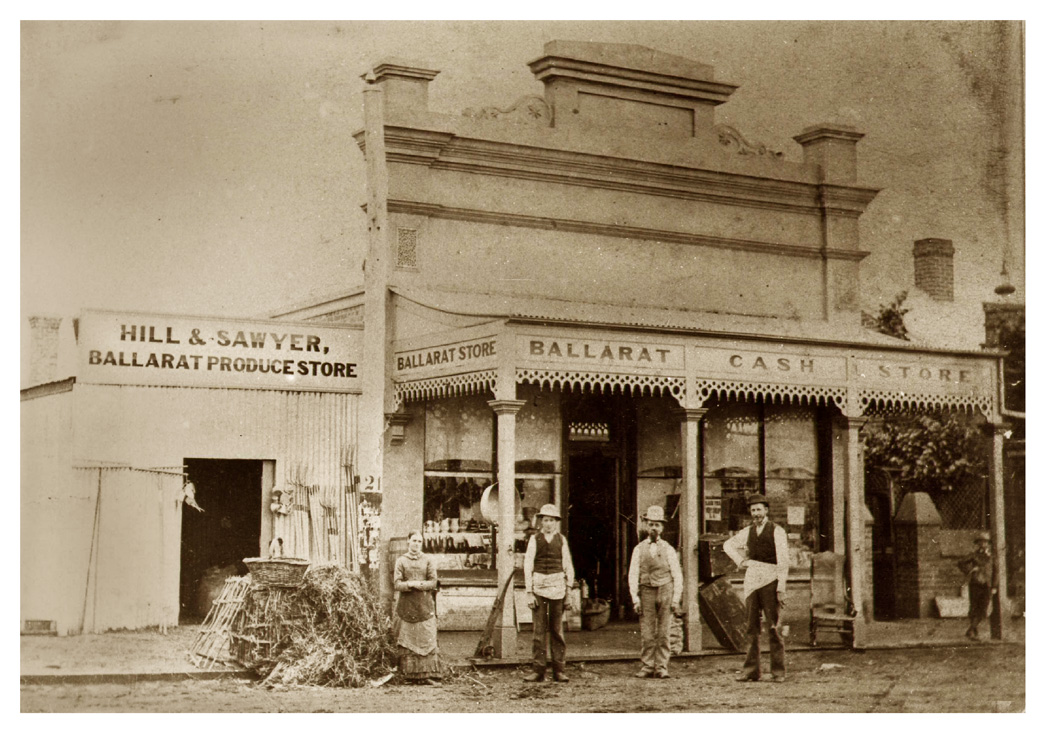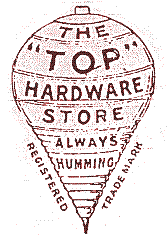
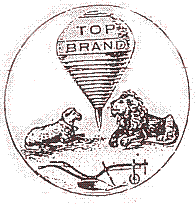
HANNAH FAMILY
and the
BALLARAT CASH STORE
My interest in this country general store started with the photograph above. The original is in an album compiled by my great grandfather Herbert Shaw's family and is one of a small stack of 1800s albums which are at the heart of my very long term, very intermittent project to identify all the photo subjects within. In this album most of the photos cover Herbert's immediate family in Melbourne in the early 1890s and then later in Perth, but there are a few that show country scenes. Some have captions identifying locations in north east Victoria and Ballarat seemed to be the obvious location for this one. Another pair of photos show a newly built verandahed house and a large hotel standing starkly in an unidentified location on a small hill. Based on the similarity of format I had assumed that they were all taken or collected by Herbert on a trip to Victoria's Wimmera and Mallee, possibly as a representative of the his father's wholesale hardware business, Alfred Shaw & Co,
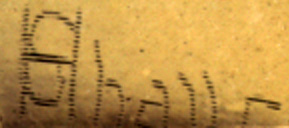 Later I Iooked more closely at the Ballarat Cash Store photo and found the signature of "H Shaw", probably scratched directly onto the glass negative. A photo from 1890 of Herbert's future wife's home has a similar signature. Without much further thought I made a tentative identification of the central hatted figure as Herbert's brother-in-law and friend Theo Felstead and dated the photo as a bit earlier than December 1894 when Herbert left for the West followed shortly afterwards by Theo.
Later I Iooked more closely at the Ballarat Cash Store photo and found the signature of "H Shaw", probably scratched directly onto the glass negative. A photo from 1890 of Herbert's future wife's home has a similar signature. Without much further thought I made a tentative identification of the central hatted figure as Herbert's brother-in-law and friend Theo Felstead and dated the photo as a bit earlier than December 1894 when Herbert left for the West followed shortly afterwards by Theo.
This all proved to be completely wrong. An email from a relative of Alfred Shaw's second wife Margaret Wilson mentioned that Margaret's sister Elizabeth had married a Robert Campbell Hannah. A dim memory led me back to the photo and the name on the store front. Armed with this connection and much help from the Donald Archivist, the photo's location was identified as 8 Wood Street, Donald and R C Campbell revealed as the store owner and a well known early Donald identity. It is almost definitely him with the hat, his sons on the buggy and wife and a daughter on the right. Much is still unclear but the story of the the Ballarat Cash Store seems to be somehow interwoven with that of Alfred Shaw and his family and business so I'll start with as much history as I have on the store (it would be a shame not to find a use for all the photos of the store).
This uncaptioned photo from a local history publication was sent to me by the Donald History Group. Accompanying it were a series of local newspaper item summaries providing a brief outline of the store's early history. Based on this history and the other photos this one seems to have been taken about 1882 or 1883. The most likely candidates for the two middle figures are the original owner Alfred Hill with bowler hat and possibly his successor, James William Daniel Robinson to his left. There is another photograph of the store apparently taken when it was owned by "A Hall" (sic) but this seems to have been taken a few years later judging by the improvements to the facade of the next door building (below left).
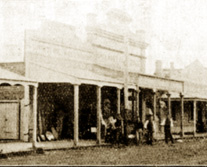
 From at least 1879 Mr. Hill had run a "Ballarat Cash Store" in the neighbouring town of St Arnaud in partnership with a George Sawyer. In 1881 he paid £800 to buy an existing store from one of Donald's earliest pioneers, Johann Meyer. The following is from a history on the official Donald web site - "In 1863 an enterprising businessman named Johann August Meyer saw an opportunity to set up a store and liquor shanty by a bridge that had been built over the Richardson upstream from the Banyenong homestead. It was a crossing and camping place for teamsters, travellers, drovers and herdsmen. The shanty met strong objections from William Donald and other pastoralists, as shepherds were being enticed from their lonely vigil, minding sheep in the unfenced land. When a road from St. Arnaud to Morton Plains was surveyed in 1864, the bridge was re-located, and Johann Meyer built a weatherboard store and hotel near the site of the present Mt. Jeffcott Hotel. Edward Miller followed him, building his Royal Hotel, and this was the nucleus of the town that was called Richardson Bridge until the name "Donald" appeared on a survey map in 1866." This is probably the business that later in the the early 1900s was described on the storefront described as "Est. 1866".
From at least 1879 Mr. Hill had run a "Ballarat Cash Store" in the neighbouring town of St Arnaud in partnership with a George Sawyer. In 1881 he paid £800 to buy an existing store from one of Donald's earliest pioneers, Johann Meyer. The following is from a history on the official Donald web site - "In 1863 an enterprising businessman named Johann August Meyer saw an opportunity to set up a store and liquor shanty by a bridge that had been built over the Richardson upstream from the Banyenong homestead. It was a crossing and camping place for teamsters, travellers, drovers and herdsmen. The shanty met strong objections from William Donald and other pastoralists, as shepherds were being enticed from their lonely vigil, minding sheep in the unfenced land. When a road from St. Arnaud to Morton Plains was surveyed in 1864, the bridge was re-located, and Johann Meyer built a weatherboard store and hotel near the site of the present Mt. Jeffcott Hotel. Edward Miller followed him, building his Royal Hotel, and this was the nucleus of the town that was called Richardson Bridge until the name "Donald" appeared on a survey map in 1866." This is probably the business that later in the the early 1900s was described on the storefront described as "Est. 1866".
The photo above right is Hill's St Arnaud store in the late 1800s. All I know about this photo is that it was used as a postcard and postmarked in 1906 but looks to have been taken quite a bit earlier. Apparently the Brays of the sign were well established in St Arnaud with this inducement appearing on a Victorian tourism website - "Visit Australia’s oldest family-owned business – Bray’s Menswear & Drapers – and ask about its flying fox cash transfer system". Maybe they bought the St Arnaud store from Alfred Hill in 1885 at the same time he sold the Donald store to JWD Robinson. By that time the partnership with George Sawyer had been dissolved for 3 years.
When he bought the Donald store JWDR had been Alfred Hill's Donald store manager for about a year. Before that he had lived in St Arnaud and according to a speech he made later on leaving Donald for good he had worked for the Hill business from about 1878. He had been born in 1857 in Ballarat to James Nichols Robinson, an American ship's carpenter who arrived in Australia in trhe early 1850s probably for the gold rushes. His mother died in 1870 leaving James and five sisters, four under 10 and Mary Jane about 16 who died in 1877. Not much is known of how the family managed after Isabella's death.
In 1881 JWDR married 17 year old Harriet Lowe of St Arnaud and it may be that I'm doing him a disservice but he seems to have applied his imagination to some of the details on his marriage certificate. The document's quality is poor but his place of birth seems to be recorded as "Boston, America" and his father's occupation as "Shipbuilder" which I guess is not far removed from ship's carpenter. Maybe this was just evidence of the same creativity and sense of adventure that fits with a young man who 3 years after buying the store picked up and left his home area with wife, an adopted daughter and younger sister for the Melbourne area to try his hand at various careers and before heading west to the latest goldrush.
 How was JWDR connected to my Shaws? The "SPECIAL BUSINESS NOTICE" in the Donald Express of July 5th, 1889 records that he has "disposed of the business carried on by me during the past eleven years, at the BALLARAT CASH STORE to MR. R. C. HANNAH", Alfred Shaw's brother-in-law. He signs off with "From the old established firm of ALFRED SHAW & CO., wholesale Merchant, Melbourne ....." which suggests he had taken a job with the company maybe as part of terms of the sale.
How was JWDR connected to my Shaws? The "SPECIAL BUSINESS NOTICE" in the Donald Express of July 5th, 1889 records that he has "disposed of the business carried on by me during the past eleven years, at the BALLARAT CASH STORE to MR. R. C. HANNAH", Alfred Shaw's brother-in-law. He signs off with "From the old established firm of ALFRED SHAW & CO., wholesale Merchant, Melbourne ....." which suggests he had taken a job with the company maybe as part of terms of the sale.
From the early 1890s and then to the end of the century JWDR appears in Wise's Directory as a poultry farmer of Pakenham. Did he finish up his employment at AS & Co. soon after leaving Donald, maybe as a result of the company's woes. The photo on the left includes Lavinia Shaw's caption which identifies JWDR and Mrs (Harriet) Robinson, "sister", Lizzie Wright Robinson, and "adoption", (almost certainly the daughter who left the Donald District with the family in September 1889 and probably Ethel Robinson, daughter of Lizzie). The caption suggests that the two families were close. A second photo taken on the same day shows the Robinson's Pakenham house. I've since found that the house sat in the middle of a 40 acre property on a hill a few miles from Pakenham station and is still standing in 2016. The property was named "Minnehaha" almost certainly by JWDR in what was surely a friendly play on the name of Herbert Shaw's childhood home, "Hiawatha".
This was no battery farm. JWDR was a "fancier" who bred show quality birds and numerous newspaper articles of the time exalt the quality and variety of his offering and his influence on neighbours who took up similar enterprises. It is interesting to note that Herbert Shaw became something of a celebrity for the quality of his poultry during his time in Collie. Did he learn this art from JWDR, a professional chook farmer in these pre-battery farm days? The Shaw family had all moved to Western Australia between 1894 and 1901, and by 1901 JWDR was residing there as well and describing himself as a mercer or draper. JWDR may well have visited Herbert in Collie or at least would have seen him in the then semi-rural South Perth .
The 1901/1906 electoral rolls show JWDR as being in Fremantle but the second was probably out of date. More likely to be correct are the post office directory entries from 1901 and later placing him in business as a storekeeper in in the new gold town of Laverton a few hundred miles north east of Kalgoorlie, and then Warriedar, inland from Geraldton. Like Herbert Shaw in Collie, Ernest Shaw in Busselton and for a while their father in Coolgardie, JWDR seems to have been trying to recreate the story of stores like the Ballarat Cash Store which had supplied the Victorian goldrushes of 50 years earlier. Unsurprisingly the name of his store in remote Laverton was the "Robinson's Ballarat Cash Store" and this is what is pictured at the top of this section. The couple with the teenage girl outside surely couldn't be anyone but the Robinsons with adopted daughter Ethel.
The various small biographies of Robert Campbell Hannah provide sometimes contradictory impressions of his origins. His entry in "The Cyclopedia of Victoria, 1890" paints him as a well-educated and privileged member of the landed gentry dabbling in agriculture and horse racing, while later newspaper articles refer to the "humble village" of his birth. A 1920s photo of him in a kilt and full Scottish regalia and his prominent role in the local Caledonian Society suggest strong pride in his native country but an interest in things Irish is indicated by his donation to Parnell's Irish National League in 1893 and his involvement in local St Patrick's Day celebrations.
As is common the story is probably a bit more complex than can be squeezed into any short biography. He may well have studied at the ancient Ayr Academy but by the time he was 20 he was described as an Ironmonger's Assistant and was living in the main street of Girvan on the South Ayrshire coast. His father John, variously described as a Grocer, a Wine Merchant and a Sawyer, had died in 1858. In 1841 John had been living with his brother Robert and both were described as being born in Ireland but by 1851 John's birthplace had undergone a transformation and was recorded as Girvan. Maybe he was born in transit his two next younger siblings were born in Girvan very shortly after his birth year.
RC's mother Jessie lived on into the 20th century drawing on "private means". It seems likely that in 1871 RC was assistant to his uncle Robert who was an ironmonger in Girvan from before 1851 until his death in 1872. He was ill for two years prior to his death so maybe RC was taken on as his assistant with the aim of learning the business. This set me to wondering whether ironmongery was somehow the connection to the Shaws. Did they have dealings during this time with Alfred Shaw & Co which in 1872 had opened offices in London run by the Irishman Matthew Gill?
 The possibility of an occupation in the ironmongery business seems to dissappeared with his uncle's death and by the time of his marriage at "Clachanton" both Robert and his late father were described as Landed Proprietors, with Robert being of "Auchinvale". I've been unable to find this address but in1881 Robert and his family were living in Main Street, Colmonell so it is likely that that is where Auchinvale was.
The possibility of an occupation in the ironmongery business seems to dissappeared with his uncle's death and by the time of his marriage at "Clachanton" both Robert and his late father were described as Landed Proprietors, with Robert being of "Auchinvale". I've been unable to find this address but in1881 Robert and his family were living in Main Street, Colmonell so it is likely that that is where Auchinvale was.
Also in Main Street was the home and farm for many years of Elizabeth's late father, William Wilson, a surgeon. In 1881 Elizabeth's sister Agnes Wilson is shown as the head of Clachanton Farm which is described as being "300 acres, 65 arable, employing 2 men and 2 girls". This map shows the village in 1857 with Clachanton just to the east. Clachanton Hill is just outside the top of this map with Girvan about 10 miles beyond. Just off Girvan in the Irish Sea is the small island Ailsa Craig. The town of Girvan and Ailsa Craig are central to the story of the cannibalistic Sawney Bean and clan and it is said that the island was named for his daughter hanged from the "Hairy Tree" in the 16th cenrtury. The exact location of the is lost but it was supposed to have been in Dalrymple Street, where Robert spent his early life.
 The River Stinchar shown on the map flows down the valley five miles to its mouth at Ballantrae and it can be seen on this 1890s view found in my great Aunt Lavinia's album. It looks across the town to the island of Ailsa Craig. Beyond and to the left of the island can be seen Mull of Kintyre and to the right is the southern tip of the Isle of Arran. Someweher there too distant to see sits the hamlet of Shannochie. I spent the summer of 2001 there often looking out at Ailsa Craig, and oblivious to any connection I might have had to the clearly visible Ayreshire coast in the far distance. Ignorant also that in the other direction behind Arran along the Kintyre coastline was Lochgilphead, the home of my Murrays before they moved on to Glasgow.
The River Stinchar shown on the map flows down the valley five miles to its mouth at Ballantrae and it can be seen on this 1890s view found in my great Aunt Lavinia's album. It looks across the town to the island of Ailsa Craig. Beyond and to the left of the island can be seen Mull of Kintyre and to the right is the southern tip of the Isle of Arran. Someweher there too distant to see sits the hamlet of Shannochie. I spent the summer of 2001 there often looking out at Ailsa Craig, and oblivious to any connection I might have had to the clearly visible Ayreshire coast in the far distance. Ignorant also that in the other direction behind Arran along the Kintyre coastline was Lochgilphead, the home of my Murrays before they moved on to Glasgow.
If these connections weren't enough, in a moment of revelation the significance of this view hit me. Some time after 1891 the mother of Margaret Shaw and Elizabeth Hannah had moved to Ballantrae. The youngest daughter of Alfred Shaw and Margaret Wilson was born in February 1892 shortly after her family had returned from an extended visit to Britain. This was sure to have included a trip to Ayrshire to see Margaret's mother. The name given the youngest of the Shaws was Ailsa Wilson Shaw.
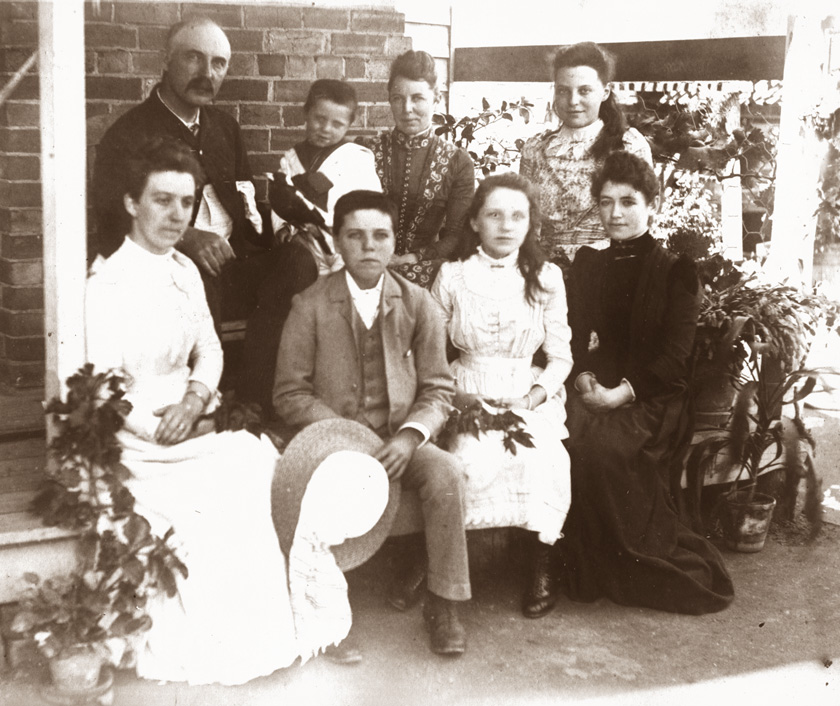 In November 1886 Robert was in London to witness the wedding of his sister-in-law Margaret Wilson to Alfred Shaw. Margaret's address at the time was Fulham Park Gardens in west London and it is possible that this address may have been used by the Hannah family while in London. The wedding was held in Crouch End and Alfred was staying nearby at "Strathearn" the home of his London business manager, Matthew Gill. We can only speculate on what converstaions took place but within the year Robert had sold up in Scotland emigrated to Victoria arriving on the Shannon in January 1888. Possibly for reasons of health his youngest daughter didn't accompany them and was still in Scotland in 1891 with her grandmother. It's not clear how or with whom she travelled but judging from this family group from the Shaw albums she was with the family in Donald shortly afterwards. The identity of the woman in white is not known but maybe she was a nurse who accompanied Alice on the voyage.
In November 1886 Robert was in London to witness the wedding of his sister-in-law Margaret Wilson to Alfred Shaw. Margaret's address at the time was Fulham Park Gardens in west London and it is possible that this address may have been used by the Hannah family while in London. The wedding was held in Crouch End and Alfred was staying nearby at "Strathearn" the home of his London business manager, Matthew Gill. We can only speculate on what converstaions took place but within the year Robert had sold up in Scotland emigrated to Victoria arriving on the Shannon in January 1888. Possibly for reasons of health his youngest daughter didn't accompany them and was still in Scotland in 1891 with her grandmother. It's not clear how or with whom she travelled but judging from this family group from the Shaw albums she was with the family in Donald shortly afterwards. The identity of the woman in white is not known but maybe she was a nurse who accompanied Alice on the voyage.
There is an eighteen month period between Robert's arrival and the official take over of the Donald Ballarat Cash Store in July 1889. The familys residence and Robert's activities during this time are unclear but we can speculate. Robert too may have speculated and there is mention of money lost in an unsuccessful venture in mining. This was the height of Victoria's boomtime and not long before it all turned to bust so it is not surprising that a new arrival might be lured into unsound investment but it does beg the question as to why he wasn't protected or advised by Alfred with his extensive local connections.
I've found no record of where the family lived during this period but there do seem to be some clues to suggest they stayed with Alfred and family at the newly purchased mansion "Hiawatha" in Brighton. If they weren't at the house itself they may have been close by as it seems they came to know the Binnie family next door well enough for them to have sent a wedding gift to Alice Hannah years later. Maybe there was a business relationship as John Binnie was an importer and wholesaler , or maybe it was another "Mr and Mrs Binnie" altogether. Another gift at Alice's wedding was from "Teenie" and earlier a "Tennie" had sent a gift to her sister Jessie for her wedding. Teenie or Christina Stevenson, was the Shaws' nanny and remained with family for 50 years. She was originally from Scotland and accompanied the Shaw family on at least one trip to England where she may have met the Hannahs. During 1888 she was sure to have seen much of the Hannahs who like the Shaws had very young children.
Donald 1890s?
The Store in 1911
(Thanks to the Donald & District Archives for these photos)

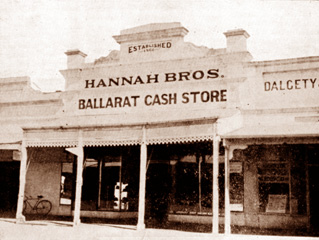 The photo on the left came with the description "Robert Campbell Hannah and daughter". The women's clothes suggest c1910 so maybe this is Williamina about the time of her marriage. RC's costume provides little in the way of clues but he appears to be about 60 years old.
The photo on the left came with the description "Robert Campbell Hannah and daughter". The women's clothes suggest c1910 so maybe this is Williamina about the time of her marriage. RC's costume provides little in the way of clues but he appears to be about 60 years old.
The other photo is of the store in about 1925, shortly before a major renovation.

